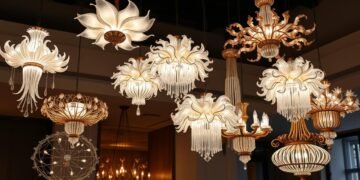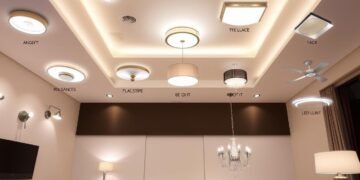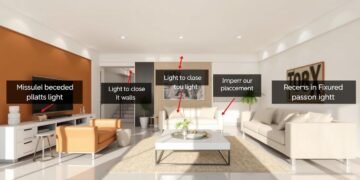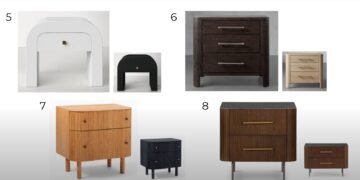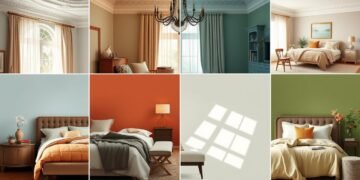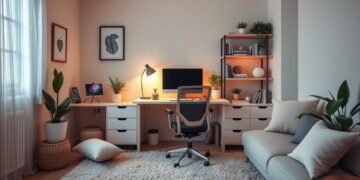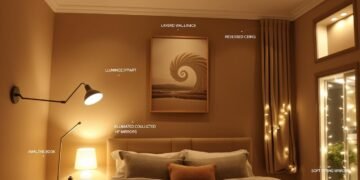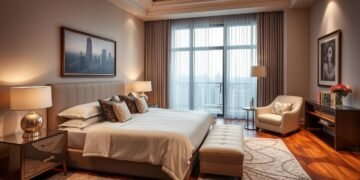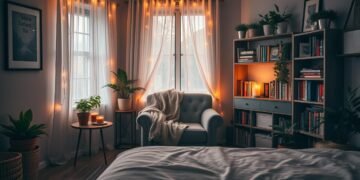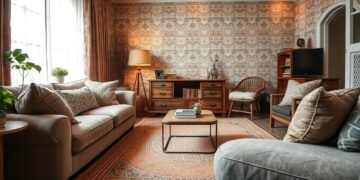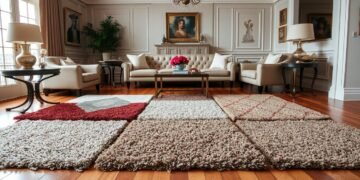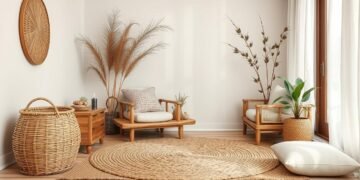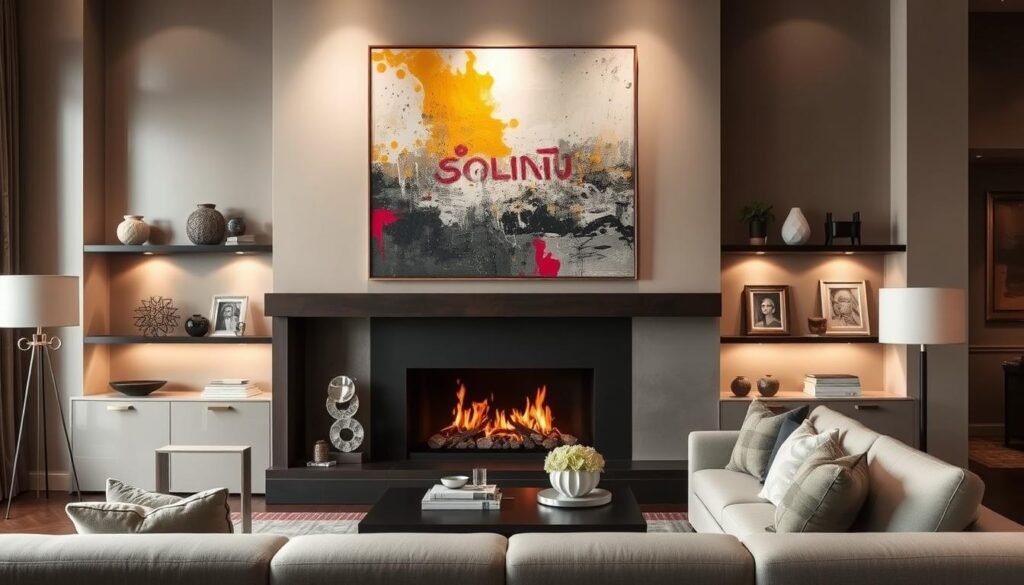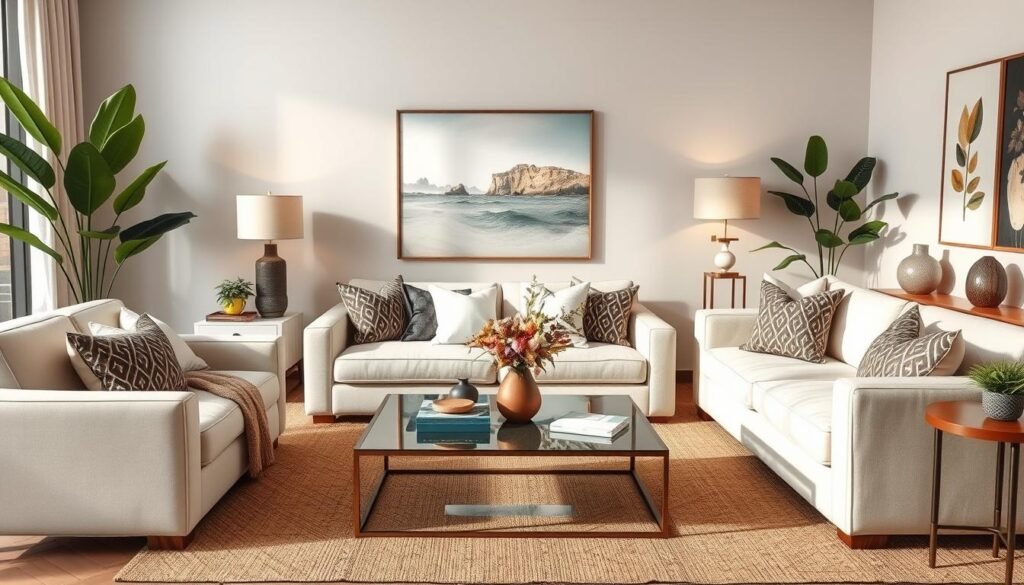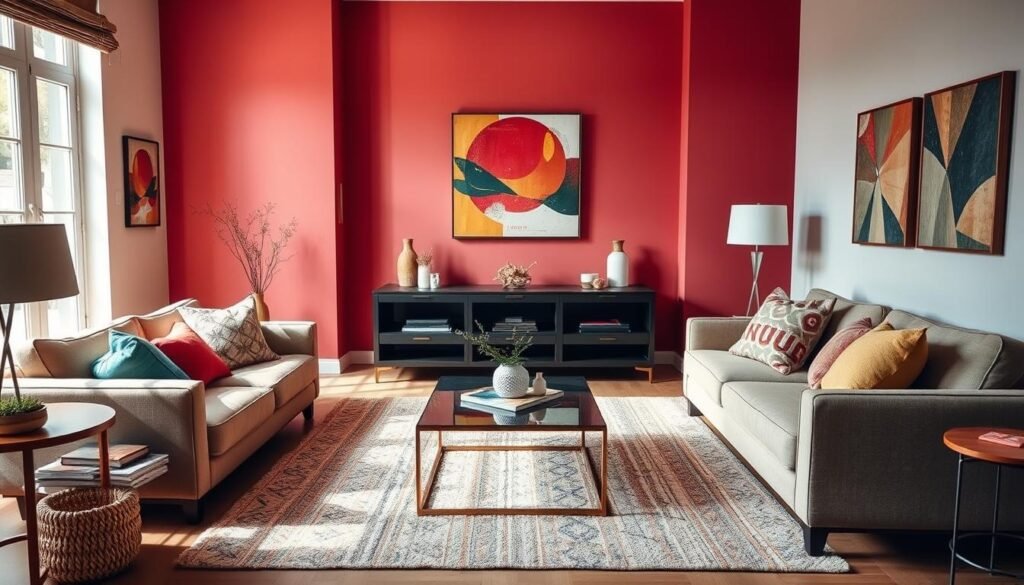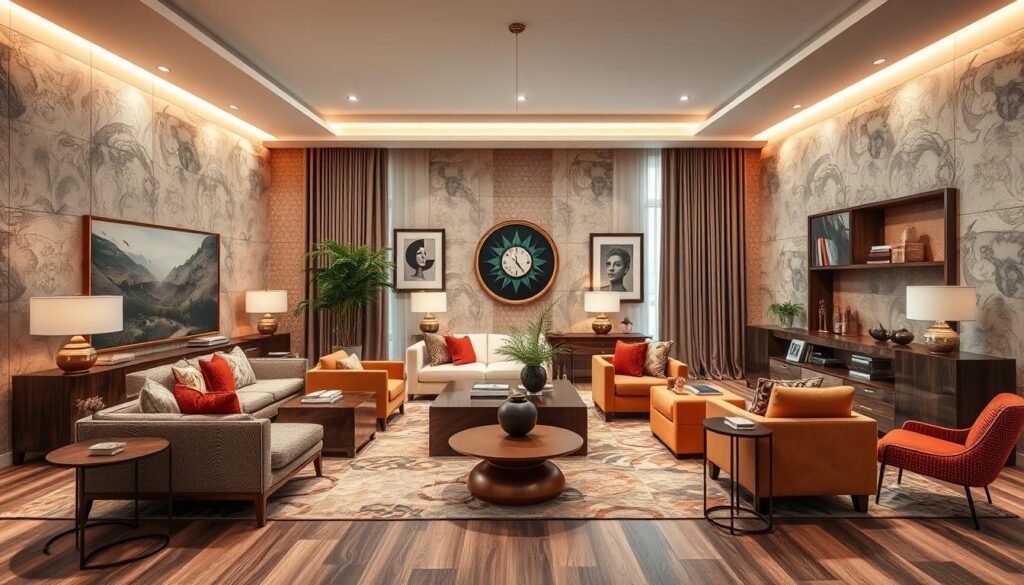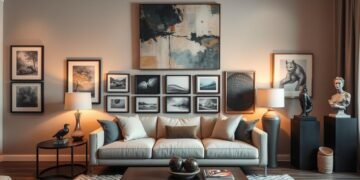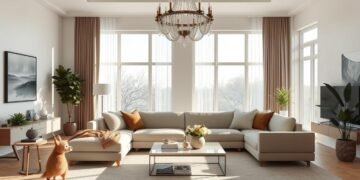When you enter your living room, you notice how everything fits perfectly together. This is the magic of proportionate décor arrangements. It’s about balancing scale, proportion, and visual weight for a beautiful interior design. We’ll share five easy techniques to make your home look stylish and sophisticated.
Table of Contents
- 1 Understanding the Fundamentals of Proportionate Design
- 1.1 The Role of Visual Weight in Room Design
- 1.2 Basic Principles of Scale and Balance
- 1.3 Impact of Room Dimensions on Décor Choices
- 1.4 Relatedarticles
- 1.5 8 Approaches to Choosing the Perfect Focal Point for Any Room
- 1.6 7 Rules for Placing Artwork at the Right Height and Scale
- 1.7 5 Common Scale Mistakes and How to Correct Them
- 2 The 60-30-10 Rule for Balanced Interior Design
- 3 Creating Harmonious Focal Points in Your Space
- 4 Proportionate Décor Arrangements for Different Room Sizes
- 5 Color and Texture Balance in Interior Spaces
- 6 Symmetrical vs Asymmetrical Balance in Room Design
- 7 Strategic Furniture Placement and Space Planning
- 8 Lighting and Its Role in Proportionate Design
- 9 Incorporating Decorative Accessories and Art
- 10 The Art of Scaling Décor Elements
- 11 Conclusion
- 12 FAQ
- 12.1 What is the importance of proportionate décor arrangements in interior design?
- 12.2 What is the concept of visual weight in room design?
- 12.3 How can the 60-30-10 rule help in creating balanced interior design?
- 12.4 What is the role of focal points in proportionate décor arrangements?
- 12.5 How can you adapt décor arrangements to different room sizes?
- 12.6 What is the importance of color schemes and textures in proportionate décor?
- 12.7 How can symmetrical and asymmetrical balance be used in interior design?
- 12.8 What are the key considerations for strategic furniture placement?
- 12.9 How can lighting contribute to proportionate décor?
- 12.10 What is the importance of accessories and art in proportionate décor arrangements?
- 12.11 How can you scale décor elements to achieve proportionate design?
- 13 Source Links
Key Takeaways
- Understand the importance of visual weight, scale, and proportion in creating balanced compositions.
- Discover the impact of room dimensions on your décor choices and how to optimize the scale.
- Explore the 60-30-10 rule for achieving a harmonious color palette in your interior design.
- Learn strategic techniques for placing statement pieces and using negative space effectively.
- Recognize the role of symmetrical and asymmetrical balance in creating visually appealing arrangements.
Understanding the Fundamentals of Proportionate Design
Creating well-proportioned interiors starts with knowing the basics of visual weight, scale, and room size. These elements are key to making spaces that look good and work well. They help in making rooms that are both beautiful and practical.
The Role of Visual Weight in Room Design
Visual weight is how heavy or dominant objects seem in a room. Learning to control visual weight is vital for a balanced look. By picking the right furniture, art, and accessories, you can spread out the visual weight. This makes sure nothing takes over the room’s design.
Basic Principles of Scale and Balance
Scale and balance are at the heart of good design. Scale is about the size of things compared to their surroundings. Balance is about arranging these elements in a way that looks right. Using these principles helps avoid rooms that feel too small or too big. Proportional design principles guide how dimensions of architectural components are constructed to achieve balance and beauty.
Impact of Room Dimensions on Décor Choices
The size of a room greatly affects what you can put in it. Knowing how room size and décor interact is key to a balanced space. Big rooms need big furniture and bold designs to look right. Small rooms need smaller, carefully placed items.
By understanding the basics of proportionate design, you can make spaces that look great and work well. Using these principles in your design will turn any room into a place that’s both beautiful and functional.
The 60-30-10 Rule for Balanced Interior Design
The 60-30-10 rule is key for a harmonious interior. It suggests using colors in these ratios: 60% for the main color, 30% for the secondary, and 10% for the accent. This makes your room look balanced and appealing.
The main color, 60%, goes on walls, big furniture, and rugs. It sets the room’s mood. The secondary color, 30%, is for window treatments, chairs, and bed linens. The accent color, 10%, is for pillows, art, and lights.
This rule helps your room look balanced and harmonious. It ensures no color dominates, keeping the colors in check. You can use any color scheme, like complementary or monochromatic, and the 60-30-10 rule helps.
Remember, the 60-30-10 rule is just a guide. You might need to tweak it for your space or taste. Some designers even suggest a 110% scheme with two accent colors. The goal is always to create a balanced and beautiful interior.
“The 60-30-10 rule is a timeless principle in interior design that helps create harmonious and balanced color schemes. By following this guideline, you can achieve a cohesive and visually appealing space that reflects your personal style.”
Creating Harmonious Focal Points in Your Space
Focal points are the eye-catching elements that define a room’s character. They can be a stunning piece of art, a bold accent wall, or a striking piece of furniture. Placing these statement pieces strategically is key to a harmonious and balanced interior.
Strategic Placement of Statement Pieces
To make a statement piece stand out, place it where it grabs attention but doesn’t overwhelm. Make sure its size fits the room well. Use lighting to highlight its beauty. Add contrasting textures or patterns to make it pop.
Balancing Visual Elements
To balance your space, distribute colors, textures, and shapes thoughtfully. Don’t put all the visual weight in one spot. Instead, follow the 60-30-10 rule. This means 60% of the room is a main color, 30% is a secondary color, and 10% is an accent color.
Using Negative Space Effectively
Negative space, or empty areas, is vital for avoiding clutter. Use it around focal points to let the eye rest and achieve balance. This highlights the statement pieces and draws attention to the design’s key elements.
The art of creating harmonious focal points is about finding the right balance. It involves statement pieces, visual elements, and negative space. Mastering these techniques will help you create a visually stunning and cohesive interior design.
Proportionate Décor Arrangements for Different Room Sizes
Interior design is all about balance. Making sure your décor fits the room size is key. This balance makes spaces look good and work well.
In small rooms, every inch counts. Choose furniture that does more than one thing. Use tall storage to keep things tidy. Pick smaller items to avoid feeling cramped.
Bigger rooms need special care. Create different areas for sitting, eating, or reading. Area rugs help tie these zones together. Choose furniture that fits the room’s size, keeping things balanced.
| Room Size | Furniture Placement | Décor Considerations |
|---|---|---|
| Small Spaces | – Use multi-functional furniture – Optimize vertical storage – Scale décor elements according |
– Avoid clutter – Maximize efficiency – Maintain proportionate scale |
| Large Spaces | – Define distinct zones – Utilize area rugs to anchor spaces – Select proportionate furniture |
– Avoid a sparse, disconnected feel – Create a sense of cohesion – Balance scale of items with room size |
No matter the room size, keep paths clear. This helps with both looks and function.
“The key to proportionate décor is understanding the scale and balance of the room, and then tailoring your choices according to create a harmonious and visually appealing space.”
Adjusting your décor to fit the room’s size makes your space better. It looks great and works well, showing off your style.
Color and Texture Balance in Interior Spaces
Getting the right mix of color and texture is key to making spaces look great. Knowing how to use color and texture can make your home or office look amazing. It can also set the mood and feel you want.
Implementing Color Schemes Effectively
Color is important for the feel of a room. Use the 60-30-10 rule to pick colors: 60% for the main color, 30% for a secondary color, and 10% for an accent. This balance makes the space look good and feel right.
Try different colors to add depth and interest. Use tints, shades, and contrasts to make your design pop. The color wheel helps find colors that work well together, making your space look even better.
Mixing Textures for Visual Interest
Textures add depth and feel to a room. Mix smooth and rough, soft and hard textures to make your space interesting. This mix makes your space feel rich and engaging.
Play with fabrics, finishes, and materials like velvet, leather, wood, and metal. Mixing these textures creates a space that looks great and shows off your design skills.
| Textural Element | Example | Visual Impact |
|---|---|---|
| Smooth Surfaces | Polished marble, glass, lacquered furniture | Reflective, calming, and elegant |
| Rough Surfaces | Exposed brick, natural stone, woven textiles | Organic, earthy, and visually stimulating |
| Soft Textures | Plush rugs, velvet upholstery, cashmere throws | Cozy, inviting, and visually soothing |
| Rigid Textures | Metal accents, solid wood furniture, ceramic tiles | Sleek, modern, and visually grounding |
Mastering color and texture balance makes spaces that are stunning and emotionally engaging. These spaces leave a lasting impression on everyone who sees them.
Symmetrical vs Asymmetrical Balance in Room Design
Getting the perfect balance in your decor is key to making spaces look good and feel right. You can go for symmetrical or asymmetrical balance in room design. Knowing the difference can make your living areas look better.
Symmetrical balance is all about mirroring elements on both sides of a central point. It makes spaces look balanced and harmonious. This style works best in rooms that are square or rectangular, as they have even sides.
Asymmetrical balance, on the other hand, lets you play with different elements like size and color. It adds interest and makes spaces feel more relaxed and welcoming. This style is great for rooms with unique features.
Both symmetry in decor and asymmetry in decor have their perks. Symmetry is perfect for formal areas like dining rooms. Asymmetry is better for casual spaces like living rooms. The goal is to mix both for a balanced and engaging look.
“Balancing different design approaches such as symmetry, asymmetry, and radial balance is essential for creating dynamic yet cohesive interiors without overwhelming the space.”
Understanding symmetrical and asymmetrical balance lets you create spaces that are both harmonious and visually appealing. This way, you can turn your living areas into places of beauty and comfort.
Strategic Furniture Placement and Space Planning
Creating a beautiful and useful interior is more than just placing furniture. It’s about how you place things to make your space flow well and look good. By learning how to arrange furniture, you can make a welcoming space that looks great and works well.
Creating Optimal Traffic Flow
Putting furniture in the right spots is key for easy movement in your rooms. Set up your furniture so people can move around easily. Make sure there’s enough room for walking and don’t block important paths.
Think about where people will enter and leave your space when you plan your layout.
Furniture Grouping Techniques
Grouping furniture helps make zones and cozy areas in big spaces. Place seating around a central point, like a fireplace or TV, to make talking easier. Mix big pieces with small ones to keep the room balanced.
Use furniture to guide the eye and show what the room is for.
| Furniture Arrangement Technique | Benefits |
|---|---|
| Symmetrical Arrangement | Brings a sense of order and calmness to a room |
| Asymmetrical Arrangement | Adds visual interest and a more dynamic feel |
| Furniture Floating Away from Walls | Creates a more intimate and engaging environment |
| Utilizing Multi-Functional Furniture | Saves space and increases functionality in smaller rooms |
Learning about furniture arrangement, space layout and furniture, room flow, and furniture placement can change your living areas. You can make them both useful and beautiful, fitting your style and needs.
Lighting and Its Role in Proportionate Design
Lighting is key to a well-balanced and cohesive interior. It affects the room ambience and the decorative scale of your furniture. This leads to a unified look in the room.
Choosing the right lighting is important. It should match the room’s size. For example, pendant lights should be hung at the right height to not overwhelm the space.
For dining tables, keep pendant lights at least 12 inches away. This avoids clutter and makes the space look better.
In rooms with low ceilings, hang pendant lights 60 to 80 cm above the table. This creates a balanced look. Lights with detailed glass, like the Celeste or Ballroom collections, add beauty without making the room feel small.
| Lighting Fixture | Recommended Placement |
|---|---|
| Pendant Lights | 60-80 cm above dining table |
| Chandeliers | Suitable for rooms with higher ceilings |
| Wall Sconces | Complement the main light source |
| Floor Lamps | Enhance the room’s ambiance |
In rooms with tall ceilings, a big light fixture plus smaller ones like sconces and floor lamps works well. Chandeliers, like those from the Tears from Moon or Embrace and Infinity collections, add elegance.
By mixing different lighting proportions, you can make your space look great. It shows off the decorative scale and visual cohesion of your room. This improves the room ambience overall.
Incorporating Decorative Accessories and Art
Decorative accessories and artwork can make any space unique and interesting. They add a personal touch and visual appeal. By choosing them wisely, you can enhance the design and create a balanced atmosphere.
When placing accessories, remember the rule of three. Group items in odd numbers to catch the eye and look good. Make sure the size of your accessories fits well with the room and furniture.
Choosing the right spot for your artwork is key. Pick pieces that fit the wall size and hang them at the right height. Try different layouts, like gallery walls or uneven groupings, to add depth and personality.
- Use accessories to add pops of color and texture, accentuating the overall design scheme.
- Rotate decorative objects seasonally to refresh the look and feel of your space.
- Ensure that accessories and artwork complement the existing style and color palette of the room.
| Decorative Accessory | Ideal Placement | Proportional Considerations |
|---|---|---|
| Vase | Tabletop, Sideboard, Bookshelf | Scale should balance with surrounding furniture and room size |
| Artwork | Wall, Above Fireplace, Gallery Wall | Size should be proportionate to wall space and room dimensions |
| Throw Pillow | Sofa, Accent Chair | Textile and pattern should complement the overall design scheme |
By carefully choosing decorative accessories and artwork, you can make a space that’s both beautiful and balanced. It will show off your personal style and taste.
The Art of Scaling Décor Elements
Getting the right balance in your home starts with scaling décor elements. The size and shape of things in a room greatly affect how it looks. By learning about decorative scale, you can make your space look good, feel right, and show off your style.
Height Considerations in Design
Height is key when scaling décor. Mixing different heights in your room adds depth and interest. Use tall items like floor lamps or big art with shorter ones to make the room feel bigger. Make sure your lights match your ceiling height for the right amount of light.
Width and Depth Proportions
Width and depth are also important for balance. Think about how your furniture fits in the room. Use the golden ratio to help choose sizes that look good together. For example, art should cover about two-thirds of the wall above a sofa or table.
Focus on decorative scale, size balance in decor, height proportions in decor, and proportional furniture placement to make your space look great. Learning to scale décor can turn any room into a cozy, stylish place that shows off your taste.
“Proportion is not just about size, but about the relationship between the parts. It’s about creating a sense of balance and harmony in a space.”
| Design Element | Proportion Considerations |
|---|---|
| Furniture | Consider the width, depth, and height in relation to the room size. Use the golden ratio as a guide. |
| Artwork | Scale artwork to cover approximately two-thirds of the wall space above furniture. |
| Lighting | Ensure light fixtures are proportionate to the ceiling height and room size. |
| Accessories | Mix items of varying scales to create visual interest and balance. |
Conclusion
Proportionate décor arrangements are key to making interiors look good and work well. By using scale, balance, and proportion, you can make spaces that feel welcoming and stylish. It’s important to think about each room’s unique features and adjust your approach.
With practice, arranging décor will become second nature. You’ll turn your homes into beautiful, balanced places. Whether it’s a cozy corner or a big living room, knowing how to design will make your spaces stunning. This will also improve your mood and enjoyment of your home.
Start using proportionate décor to make your spaces amazing. By finding the right balance, you’ll create interiors that impress and inspire. Your home will become a special place for everyone who visits.
FAQ
What is the importance of proportionate décor arrangements in interior design?
What is the concept of visual weight in room design?
How can the 60-30-10 rule help in creating balanced interior design?
What is the role of focal points in proportionate décor arrangements?
How can you adapt décor arrangements to different room sizes?
What is the importance of color schemes and textures in proportionate décor?
How can symmetrical and asymmetrical balance be used in interior design?
What are the key considerations for strategic furniture placement?
How can lighting contribute to proportionate décor?
What is the importance of accessories and art in proportionate décor arrangements?
How can you scale décor elements to achieve proportionate design?
Source Links
- Home Design Tips: How To Arrange Accessories In Your Home
- 12 Must-Know Tips for Placing Furniture Like a Designer – Decorilla Online Interior Design
- What is the Basic Rule of Floral Arrangement? | DIY Wedding Flower Tips
- How to use Proportion and Scale in Interior Design (let’s know)
- Scale and Proportion in Interior Design
- Proportional Design: Theory & Architecture
- 60-30-10 Color Rule: How to Use It & How to Break It
- 60-30-10 Rule in Design – Specific Decoration Color Scheme
- 10 TIPS TO CREATE A HARMONIOUS SPACE IN YOUR HOME
- Creating a focal point for harmony, visual interest, and personal expression.
- Living Room Layout Ideas
- The Golden Rules of Proportion: Decor Laws You Need to Know
- How to Create Balance in Interior Design
- Colour in Interior Design: Part 1
- How To Use Scale and Proportion in Interior Design? | Foyr
- Understanding Radial Balance in Interior Design
- The Art of Symmetry: Balancing Aesthetics in Room Layouts
- Symmetry and balance in interior design: the secret to perfect harmony – ALMA de LUCE
- The Interior Design Institute
- Maximize Your Space: The Ultimate Guide to Furniture Arrangement – UK Construction Blog
- How Arrange Your Furniture to Optimize Your Space – Blog – Interiors by Brown
- Implication of Scale and Proportion in Interior Design
- 3 key considerations to ensure the right lighting fixture – ILFARI
- Why You Need to Know the Rules of Proportion When Decorating
- Interior Decorating: Elevate Your Home Aesthetics with Style
- The Art of Decorating and Placing Furniture in Your Open-Concept Living Space | Caviness & Cates | New Homes for Sale in Fayetteville, NC
- Break the Rules: Mixing Different Styles for a Unique Interior Design Aesthetic
- bloomsbythebox.com
- Scale And Proportion – Interior Design — drift & co
- The Power of Scale & Proportion with Harmony & Balance
- The Importance of Proportion In Design | Third Wunder
- The Art of Furniture Arrangement in Long Living Rooms

